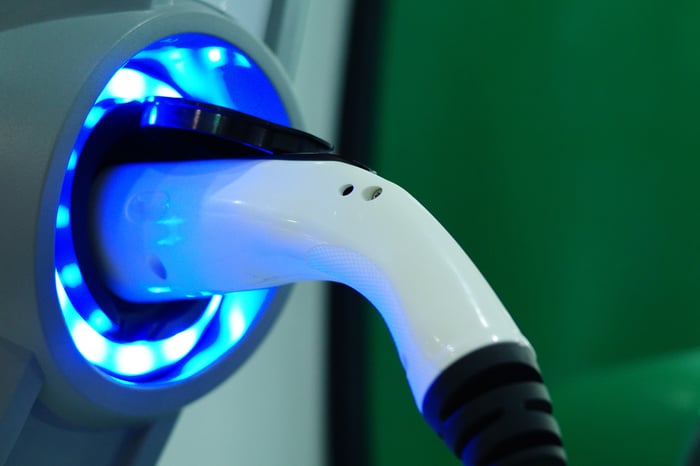Check out the latest Albemarle earnings call transcript.
Albemarle (ALB 0.31%) has caught the attention of investors over the last few years because of its lithium business. The market for that single commodity has huge growth potential, and rising demand has already helped to spur a massive price increase in the metal. That price spike has cooled since early 2018, but the demand outlook for this business hasn't. Which is why Albemarle is likely to look a lot different in five years than it does today.
The current view
Right now, Albemarle has three primary divisions. The smallest produces bromine, which is used as a fire retardant in electronics, among other things. This group provides roughly 27% of the company's revenue. The catalysts division makes products for the refining and petrochemicals markets, among others, and accounts for around 33% of the company's sales. The largest operation is Albemarle's lithium business, which mines for and produces lithium, a key material used in batteries. Lithium is about 36% of the company's sales.

Image source: Getty Images
All three divisions have been doing relatively well lately. Third-quarter catalyst sales were up 15%, while bromine sales grew 9%. The weak spot was actually lithium, which posted a sales gain of just 1%. However, that was partly the result of production issues at several of Albemarle's facilities, all of which have since been resolved.
Despite being diversified relatively evenly across three different businesses, Albemarle stock has basically been trading in line with the price of lithium. That metal's price spiked in 2017, sending Albemarle's stock higher. It fell in 2018, and Albemarle's share price again followed along for the ride. Essentially, lithium is the story that's driving Albemarle's stock. But that actually makes a lot of sense, because lithium is also driving the company's future.
Meeting the demand
Albemarle is projecting demand for lithium to increase at a compound annual growth rate of 18% between 2017 and 2025. Electric vehicles are expected to be the biggest contributor to that increase, with an incredible 35% compound annual growth rate in demand over that period. Simply put, it takes a lot of batteries to power a car, and more lithium will be needed to meet that demand -- a lot more.
|
Albemarle's Lithium Demand Projections |
|||
|---|---|---|---|
|
Applications |
2017 Demand (Kilotons LCE) |
2017 to 2025 CAGR |
2025 Demand (Kilotons LCE) |
|
Transportation |
50 |
35% |
550 |
|
Consumer electronics |
60 |
8% |
110 |
|
Other/industrial |
110 |
3% to 4% |
140 |
|
Total |
220 |
Approximately 18% |
800 |
Data source: Albemarle. LCE = lithium carbonate equivalent.
Albermarle is positioning itself to stay atop the list of global lithium producers, using the profits from its bromine and catalyst operations to help fund growth on the lithium side of the business. Generally speaking, that has meant building new lithium mines and expanding operations at existing mines. For example, it late 2018 it inked a deal to acquire a 50% stake in a planned Australian lithium mine for roughly $1.15 billion. It has also been working on in-house projects.
The company's growth goals are material. It expects to increase lithium production from 65 kilotons of lithium carbonate (LCE) in 2017 to 165 kilotons LCE in 2021. After that, its next target is to ramp up production to 325 kilotons LCE, but management hasn't given any specifics on when it expects to achieve that goal. Note, however, that prior to December's Australian mine deal, the long-term goal was 225 kilotons LCE. The trend is clear: Over the next five years, investors should expect lithium to become an increasingly important part of Albemarle's business.
So important, in fact, that management has actually hinted that it might eventually be willing to jettison its bromine and catalyst operations. That would make it a pure-play lithium producer. Such a move would make sense, given that building lithium operations at such a rapid clip is an expensive undertaking.
For example, the Australian acquisition, once complete, will require the addition of nearly $1.1 billion in debt. That's projected to push the company's net-debt-to-adjusted-EBITDA ratio to 2.2. Albemarle intends to limit further acquisitions and put share buybacks on hold until it gets that figure below 1.5, which is projected to happen some time in 2021 or 2022. Selling parts or all of its other divisions would clearly speed up the deleveraging process, or provide additional capital for further acquisitions and expansion efforts.
Watch the lithium business
In short, Albemarle's top and bottom lines will increasingly be driven by lithium over the next five years. There's even a chance that lithium will end up being its only business. It's a commodity, so you'll need to watch prices as well as production if you invest here. But the one thing that is clear is that in 2024, Albemarle will be an even bigger force in the lithium sector than it is today, and that story will be a key factor driving the stock price. In fact, Albemarle could be an interesting way to play the electric vehicle space if you don't want to bet on an automaker.





